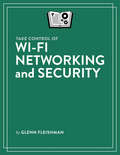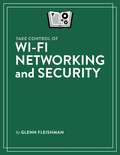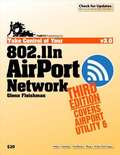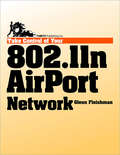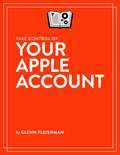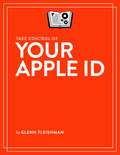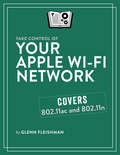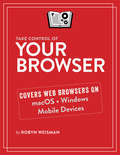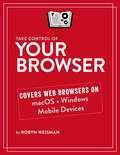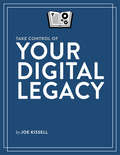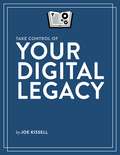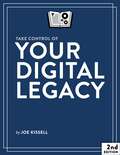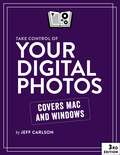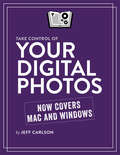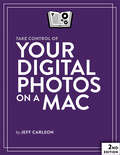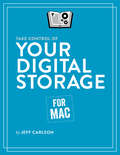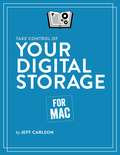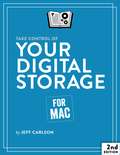- Table View
- List View
Take Control of Wi-Fi Networking and Security
by Glenn FleishmanGet more from your Wi-Fi networkPerhaps you already have a Wi-Fi network running in your home and office, but you're dissatisfied with it. Or maybe you're setting up a new house, apartment, business, or school room with Wi-Fi and need to know the basics about what to get and how to configure it. In either case, this book is for you. After over 15 years of writing regularly about Wi-Fi and answering reader questions, author Glenn Fleishman finds that the same issues still crop up:How do I spend the least money to the best effect?What's the best place to put my Wi-Fi gateways?How can I get both high throughput (speed) on my network and solid coverage across everywhere I want to use Wi-Fi?What can I do to secure my network against outsiders near my house and elsewhere on the internet?How do I add networked hard drives and printers?Interference is slowing my network; what can I do to reduce it?What's the best way to extend my network to a garage, yard, or nearby building?This book answers those questions in depth, as well as many others related to Wi-Fi, including how to set up a personal or mobile hotspot with all major operating systems, how to access computers on your network remotely, and why you should use a VPN (virtual private network).If you have any question about overhauling your network, setting up a new one, or just finally figuring out something that's never worked, this book has the answer.Covers macOS, Windows, iOS, Android, and Chrome OS.
Take Control of Wi-Fi Networking and Security
by Glenn FleishmanSetting up and securing a Wi-Fi network can be complicated and confusing. This book helps you over every hurdle involved in picking gateways, setting up a network, adding devices, and securing the network and connected phones, tablets, and computers. It’s useful for those who have set up networks in the past and want to replace them with new gear, as well as people who have never built a Wi-Fi network before.
Take Control of Wi-Fi Networking and Security
by Glenn FleishmanSetting up and securing a Wi-Fi network can be complicated and confusing. This book helps you over every hurdle involved in picking gateways, setting up a network, adding devices, and securing the network and connected phones, tablets, and computers. It’s useful for those who have set up networks in the past and want to replace them with new gear, as well as people who have never built a Wi-Fi network before.
Take Control of Wi-Fi Networking and Security
by Glenn FleishmanSetting up and securing a Wi-Fi network can be complicated and confusing. This book helps you over every hurdle involved in picking gateways, setting up a network, adding devices, and securing the network and connected phones, tablets, and computers. It’s useful for those who have set up networks in the past and want to replace them with new gear, as well as people who have never built a Wi-Fi network before.
Take Control of Your 802.11n AirPort Network
by Glenn FleishmanIf you're trying to solve a particular problem, you can jump in and read the topics in this ebook in any order, but if you start at the beginning, you'll learn how Apple's 802.11n gear fits into the world of Wi-Fi networking. With that background, you'll learn where to position and how to set up base stations, with diagrams showing common network scenarios - see two examples above - and with step-by-step instructions for configuring key Internet sharing and security options and connecting client computers. For those who have funky Internet connections or tricky IP addressing needs, Glenn provides extended advice for creating a working Wi-Fi network. Glenn provides real-world directions for important scenarios, including how to: Create a basic (or not so basic) Wi-Fi network, using Apple's base stations: Set up a wireless network with a single base station, or with multiple base stations - whether you want to extend a network with Ethernet or a wireless connection (or a mix of the two), Glenn examines your options and provides configuration steps. He also touches briefly on powerline connections. Keep your existing network, but replace an older or broken base station with a new one. Export your base station's configuration, either to make a backup or to create a model configuration to use on other base stations. Connect Macs (specific steps for 10.5 Leopard and later), iOS devices, and Windows 7 computers to your network. Set up reliable and relevant security for your network. Also, add a guest network that gives your guests Internet access while restricting their access to local resources. Attach peripherals to your network: Add a USB-connected printer, and connect to the printer from Mac and Windows computers. Add a USB-attached drive to a Time Capsule or AirPort Extreme, and configure client access. Connect a 2nd- or 3rd-generation Apple TV to your network Do more networking: Set up a Time Machine backup to a Time Capsule base station. Expand the capabilities of an AirPort Express by setting up audio streaming, trying Rogue Amoeba's Airfoil media streaming utility, or extending your network with ProxySTA. Share files conveniently and wirelessly with Lionââ⠚¬â⠞¢s AirDrop file-transfer feature, plus understand the type of networking that AirDrop uses. Put computers more directly on the Internet with port mapping or a default host. Set up Back to My Mac with iCloud in order to access an AirPort or Time Capsule drive remotely, or to configure your base station remotely. Set up a Software Base Station or do ad-hoc networking. Understand what's going on and solve problems: Find out what the icon on your Wi-Fi menu means, and discover what the colored light on your base station is trying to tell you. Learn what a MAC address is, plus how to find it. (Hint, 1 Infinite Loop is not the MAC address that you seek.) Read background information about the bands and channels used with Wi-Fi networking, understand how Apple's Wi-Fi gear fits into the picture, and get ideas for how to create an optimal network that avoids interference problems. Understand the differences among AirPort Utility 6 (for Mac), AirPort Utility for iOS, and AirPort Utility 5 (for Mac and Windows). Find a free download link for the previous edition of this ebook, which covers AirPort Utility 5. Learn how to update the firmware in your base station, and how to revert to an older version of your firmware, if necessary. "If anyone knows about real-world Wi-Fi, it's Glenn Fleishman." --Mark Frauenfelder, co-founder of bOING bOING
Take Control of Your 802.11n AirPort Network
by Glenn FleishmanMake your 802.11n-based AirPort network fast, reliable, and secure! Find real-world advice from Wi-Fi wizard Glenn Fleishman on setting up the 802.11n models of Apple's AirPort Express, AirPort Extreme, and Time Capsule, with full information about the simultaneous dual-band models introduced in early 2009. You'll get help with all the special networking details, such as how to set the best band and channel for your network, use pre-802.11n base stations and clients without hurting performance, set up complex Internet addressing, share USB disks and printers, solve a variety of problems, and much, much more. If you're trying to solve a particular problem, you can jump in and read the topics in this ebook in any order, but if you start at the beginning, you'll find a primer on important Wi-Fi networking terminology and concepts, and a look at how Apple's 802.11n gear fits into the world of Wi-Fi networking. With that background, you'll learn how to locate and set up base stations, with diagrams showing common network scenarios-see two examples above on this Web page-and with step-by-step instructions for configuring key Internet sharing and security options and connecting client computers. For those who have funky Internet connections or tricky IP addressing problems, Glenn provides extended advice for creating a working Wi-Fi network. Glenn also provides real-world steps for important add-ons to a Wi-Fi network, including: Getting started with a Time Capsule and Time Machine backups, plus thoughts on making an archive so you can have an offsite backup of your Time Capsule drive and what to do if you want to erase the driveDetailed advice for setting up a USB-based printer and for making connections to the printer work from Macintosh and Windows computersHelp with connecting an Apple TV to your network and advice on how to start syncing it to your computerSteps and configuration advice for adding a USB-attached drive to a Time Capsule or AirPort Extreme, with important information about how best to allow and configure client accessTips and setup advice for streaming music from an AirPort Express to your stereo systemDetailed configuration advice for multi-base-station networks To make your network fly, Glenn helps you: Make band and channel choicesCombine your old 802.11g network with a new 802.11n network to split traffic and maximize network bandwidthExtend your network's coverage while handling any interference Glenn also discusses wireless-network security, noting oft-suggested security approaches that don't work well and explaining how to implement measures that do work well. He covers the new guest networking option in the 2009 models of the AirPort Extreme and Time Capsule. This 'Take Control' book is a must-have for anyone who needs to quickly and easily set up an AirPort network. —Phil Kearney, "father" of Apple's AirPort product line "If anyone knows about real-world Wi-Fi, it's Glenn Fleishman." —Mark Frauenfelder, co-founder of bOING bOING
Take Control of Your 802.11n AirPort Network
by Glenn FleishmanIf you're trying to solve a particular problem, you can jump in and read the topics in this ebook in any order, but if you start at the beginning, you'll learn how Apple's 802.11n gear fits into the world of Wi-Fi networking. With that background, you'll learn where to position and how to set up base stations, with diagrams showing common network scenarios—see two examples above—and with step-by-step instructions for configuring key Internet sharing and security options and connecting client computers. For those who have funky Internet connections or tricky IP addressing needs, Glenn provides extended advice for creating a working Wi-Fi network. Glenn provides real-world steps, detailed advice, and tips for important scenarios, including: AirDrop: Finding out whether Lion’s AirDrop file-transfer feature will work with your Mac’s Wi-Fi hardwareUSB-attached printer: Setting up a USB-based printer on your Wi-Fi network, and connecting to the printer from Mac and Windows computersUSB-attached drive: Adding and configuring a USB-attached drive to a Time Capsule or AirPort Extreme, with important information about how best to configure client accessTime Capsule: Setting up a Time Machine backup to a Time Capsule, plus making an archive so you can have an offsite backup of your Time Capsule drive, and how to erase the driveApple TV: Connecting a 2nd-generation Apple TV to your networkAirPort Express: Streaming music to an AirPort Express and connecting it to your stereoGuest network: Creating a separate guest network to give guests Internet access while restricting local resourcesSecurity: Understanding oft-suggested security approaches that don't work well and implementing measures that are reliable—and easy to useMultiple base stations: Configuring multi-base-station networks, whether connected via Ethernet, wirelessly, or a combination To make your network fly, Glenn helps you: Make appropriate band and channel choicesExtend your network's coverage while handling any interferencePrevent older clients from bogging you down If you're trying to solve a problem, you'll find a "Quick Troubleshooting Guide" chapter as well as a rundown of how to interpret what the green, amber, blue, or red light on your base station is trying to tell you (we're aware of at least 11 possibilities!). The ebook also explains several ways to find a MAC address, how to handle bridging, how to set up a software base station and an ad hoc network, and what might be coming in the future with IPv6. "If anyone knows about real-world Wi-Fi, it's Glenn Fleishman." —Mark Frauenfelder, co-founder of bOING bOING
Take Control of Your Apple Account
by Glenn FleishmanThis book covers everything someone needs to know about configuring an Apple Account (formerly called Apple ID), interactions with iCloud-based services, and troubleshooting account access.
Take Control of Your Apple ID
by Glenn FleishmanPrevent (or solve) problems with your Apple ID!Your Apple ID is much more than a simple username. It's a key that unlocks a long list of Apple products and services on any of numerous devices. iCloud uses an Apple ID; so do iTunes, Apple Music, the App Store on Mac and iOS, the Books app, and more. An Apple ID protects your personal information, including email and iOS backups; helps you find a lost iPhone; and can even unlock your Mac. So it goes without saying that if something goes wrong with your Apple ID, you could be in for a world of hurt.Unfortunately, things go wrong with Apple IDs all the time. Fortunately, Glenn Fleishman, a veteran technology journalist and the author of Macworld's "Mac 911" column, is ready to help with expert advice on how to manage your Apple ID--including how to prevent, solve, or work around most common problems!In this book, Glenn answers questions like:What all is my Apple ID used for?How does my iCloud account relate to my Apple ID?What problems can two-factor authentication (2FA) solve, and how do I use it?Are there other mechanisms I can use to ensure that I can recover an Apple ID in the event of a problem? (Spoiler: yes!)What if I have a device that's too old to work with two-factor authentication?What should I do if I have two or more Apple IDs or iCloud accounts?Will I lose access to all my Apple media purchases if I move to another country?Can I share an Apple ID with someone else?What exactly should I do if I think someone is hacking my Apple ID account?How can I recover a forgotten Apple ID password?What steps should I take if Apple locks me out of my account?If I lose access to an email address associated with my Apple ID, what can I do?And that's just the beginning. Glenn has packed a remarkable amount of concise problem-solving information into this compact, 76-page book. Read it before you encounter Apple ID problems to minimize your risk, and if you've already encountered a problem, read it to find the best path to a rapid solution.
Take Control of Your Apple ID
by Glenn FleishmanThis book covers everything someone needs to know about configuring an Apple ID account, interactions with iCloud-based services, and troubleshooting account access.
Take Control of Your Apple ID
by Glenn FleishmanThis book covers everything someone needs to know about configuring an Apple ID account, interactions with iCloud-based services, and troubleshooting account access.
Take Control of Your Apple Wi-Fi Network
by Glenn FleishmanTake Control of Your Apple Wi-Fi Network: Get help with Apple 802.11ac and 802.11n networking!Although setting up a simple Wi-Fi network with Apple gear is no longer an especially geeky endeavor, making an existing network work optimally still takes effort, given the numerous possible options and places where problems can crop up.Wi-Fi wizard Glenn Fleishman helps you create a fast, reliable, and secure Apple Wi-Fi network using 802.11ac or 802.11n AirPort Extreme, AirPort Express, and Time Capsule base stations. You'll find plenty of practical directions for working with Apple's AirPort Utility 6 configuration software (for Mac and iOS), including steps for setting up a base station, swapping in new gear, adding base stations to extend your network's range, attaching USB drives or shared printers, enabling security, creating a guest network, and more. You'll also learn about what's going on behind the GUI in AirPort Utility. If you better understand channels and bands, for instance, you may be able to reconfigure your network to dramatically improve performance. And, Glenn provides advice and directions for coping with tricky IP situations.For those using older base stations or AirPort Utility 5, the ebook includes a free download of any prior edition, dating back to 2004."If anyone knows about real-world Wi-Fi, it's Glenn Fleishman." --Mark Frauenfelder, co-founder of bOING bOINGYou'll learn how to:Create a basic Apple Wi-Fi network, and connect Macs, iOS devices, and Windows 8 computers to the network.Efficiently swap in a new base station in place of an old one.Extend the range of a network by connecting base stations with Ethernet or Wi-Fi (or a mix).Print wirelessly to a Wi-Fi or USB-connected printer.Add a USB-attached drive to a Time Capsule or AirPort Extreme, and set up user access.Keep intruders out by setting up reliable and relevant security for your network. Easily put visitors on the Internet with a guest network.You'll also find information about how to:Back up to a Time Capsule, and work with the Time Capsule's internal drive.Pipe audio through an AirPort Express.Share files the new Apple way with AirDrop. You'll find lots of problem-solving help about:Avoiding interference problems.What the icon on your Wi-Fi menu means.What the colored light on your base station is trying to tell you.Dealing with a base station that can't be found on the network.Making a base station assign an IP address to a client.Finding a MAC address. (Hint, 1 Infinite Loop is not the MAC address that you seek.)Updating the firmware in your base station, and reverting to an older version.And, on the geekier side, you'll learn about:Putting computers more directly on the Internet with port mapping or a default host. Setting up Software Base Station.Ad hoc networking.Saving effort and avoiding problems by exporting a copy of a base station configuration.Accessing a base station remotely, whether to get at the contents of its drive or to configure it, via iCloud's Back to My Mac service.
Take Control of Your Browser
by Robyn WeismanYour web browser is the gateway to a vast array of information and apps. This book helps you master this essential app, finding the best browser for your needs and configuring it to work just the way you want.
Take Control of Your Digital Legacy
by Joe KissellPreserve your data for posterity!How do you want to be remembered by future generations? You can make a will to handle your physical possessions, but what about your digital life--photos, videos, email, documents, and the like? This ebook, written by tech expert Joe Kissell, covers many aspects of preserving such electronic ephemera as part of your digital legacy. If you're not at the stage of life where you can think about this for yourself, consider that you may have to do so for your parents or other relatives. It's not all about posterity either, since following Joe's advice will also help loved ones access your key accounts and important info if you're incapacitated, which can happen at any time. The book will help you with these essential tasks: Identify your key digital assets: online accounts, photos, audio files, videos, passwords, documents, email, and more. Plan for each type of digital asset based on your priorities for today, for shortly after you are no longer around, and for posterity. Joe explains the ideal file formats to use, how to deal with social media sites, the best ways to digitize paper documents and photos, and strategies for sharing passwords with family members, among much else. Communicate your wishes in a "digital will" and designate someone to be its "digital executor." The book includes a template document that you can develop into a personalized digital will. Preserve your data for the future. You'll consider types of archival storage media, cloud-based storage services, backups, and what instructions to provide about maintaining your data as file formats and storage media types evolve. Whether you just want to ensure that your heirs get copies of your favorite family photos and a few key documents or you want to catalog and preserve tens of thousands of digital items, this book helps you make smart decisions about your digital legacy. Questions answered include: What strategies can I use for sorting and preserving email? How can I ensure that my email account will be available to those wrapping up my estate? What if I have digital data that should be destroyed when I die? What should I do with my huge photo collection (both digital and paper)? How can I make my passwords available to those who will need them--but keep them private for now?What should I think about when handing down purchased audio and video files? What should happen to my Facebook account when I'm no longer around? What choices are available for keeping my digital archive available and backed up? How long should I expect archival media to last? Should I write an autobituary? Are online digital legacy services any good? How will organizing all this stuff benefit me while I'm alive?
Take Control of Your Digital Legacy
by Joe KissellHow do you want to be remembered? A will takes care of your physical possessions, but what about your digital life—photos, email, files, and the like? If you want to pass your electronic ephemera on as part of your digital legacy, turn to tech expert Joe Kissell for advice on dealing with large quantities of data, file formats, media types, the need for a “digital executor,” and more.
Take Control of Your Digital Legacy
by Joe KissellHow do you want to be remembered? A will takes care of your physical possessions, but what about your digital life—photos, email, files, and the like? If you want to pass your electronic ephemera on as part of your digital legacy, turn to tech expert Joe Kissell for advice on dealing with large quantities of data, file formats, media types, the need for a “digital executor,” and more.
Take Control of Your Digital Photos
by Jeff CarlsonThis book gives photographers using Mac or Windows computers the information they need to build and maintain a digital photo workflow that makes it easy to import, rate, tag, and store photos to find them quickly and easily later. It helps you spend more time on the enjoyable aspects of photography—shooting and viewing your photos—and less on the mundane but essential task of managing all your photos.
Take Control of Your Digital Photos
by Jeff CarlsonThis book gives you the information you need to build and maintain a digital photo workflow that makes it easy to import, rate, tag, and store photos to find them quickly and easily later. It helps you spend more time on the enjoyable aspects of photography—capturing and viewing your photos—and less on the mundane but essential task of managing all your photos.
Take Control of Your Digital Photos (1.0)
by Jeff CarlsonThis book gives photographers using Mac or Windows computers the information they need to build and maintain a digital photo workflow that makes it easy to import, tag, rate, and store photos to find them quickly and easily later. It primarily covers macOS 10.12 Sierra or later, Windows 10, and iOS 10 or later. It helps you spend more time on the enjoyable aspects of photography—shooting and viewing your photos—and less on the mundane but essential task of managing all your photos.
Take Control of Your Digital Photos on a Mac
by Jeff CarlsonBuild a digital workflow to import, tag, rate, and organize your photos!Why bother taking photos if you can't find them later? If you want to be able to lay your hands on any given photo in your ever-expanding library, digital photography expert Jeff Carlson has developed a simple system you can use to make your photo collection browsable, searchable, and generally navigable!Jeff leads off by helping you understand the strengths and weaknesses of the four most popular photo-management applications: iPhoto and Aperture from Apple, and Lightroom and Photoshop Elements from Adobe. Once you've picked the app that's right for you (and there's a chapter on migrating photos), you'll learn how to create a custom workflow for importing, evaluating, keywording, and tagging your photos so they are quickly sorted into logical groups. For each of these essential aspects of your workflow, Jeff provides step-by-step instructions for each of the four covered applications. And since it's all too easy to lose everything if you don't have backups, Jeff discusses the best way to back up and archive your photos to protect your irreplaceable photographic memories.In the process of creating your custom digital photo workflow, you'll find expert advice about each of these photo-management topics:Shooting smarter: Make sure your camera is set to the correct time (and time zone), choose a file format, and think about capturing geolocation data while you're out taking photos.Choosing the right app: Learn about the pros and cons of the most popular photo-management applications--iPhoto, Aperture, Lightroom, and Photoshop Elements--and find directions for how to migrate your photos from iPhoto to Aperture or Lightroom, or from Aperture to Lightroom.Importing photos: Make your Mac apply keywords and other tags in a batch during import, and make sure you're storing files in a place that makes sense going forward.Judging photos: Get time-tested tips for rating individual photos and learn how to deal with bad photos, whether you want to delete them, hide them, or leave them be.Assigning metadata: Once your camera and your computer have assigned as much metadata as possible automatically, you'll need to do the final bits yourself. Jeff describes how to think about this process, and he gives you specific steps for how to proceed efficiently.Putting photos in albums: With your metadata successfully applied, it's time to enjoy the fruits of your labor! Learn how to set up smart albums to collect and display your photos automatically.Planning for the future: Digital photos can't be damaged by water or tossed accidentally when cleaning house, but at the same time, a hard disk failure could destroy every photo you own. And what about preserving them for your kids? Jeff discusses how you can back up your precious photos and archive them for future generations.Bonus! Includes a 20% off coupon for SizzlPix!, high-def photographic prints infused onto an aluminum base. These hand-crafted prints are largely free of glare, are waterproof (some are installed in showers and pools), and have an ultra-hard coating that renders them virtually scratch-proof.
Take Control of Your Digital Storage
by Jeff CarlsonThe Mac user's guide to mass storageAs the amount of data we store continues to grow, figuring out where to put it and how to access it becomes more complicated. It's not just that we need to find space for our increasingly large collections of photos, videos, music, and apps--we want it to be available whenever we need it, and be sure that it's safe from hackers and thieves.Every Mac includes internal storage in the form of a hard drive, SSD, or Fusion drive. But you may also have one or more external devices (such as hard drives, flash drives, SD cards, or RAID devices), not to mention network-attached storage (NAS) devices or cloud storage (like Dropbox or iCloud Drive). Making sense of all your options, managing your stored data, choosing new devices or services when you're running out of space, or even just figuring out what's where can drive anyone to distraction.Fortunately, Jeff Carlson has a book with all the answers! After decades of working with Macs and accumulating massive collections of photos and videos, Jeff has pulled together a wide-ranging book about Mac storage that contains just the help you're looking for. Among many other topics, this book covers:How to choose a new (internal or external) hard drive, SSD, or hybrid driveDetermining how much storage space you needWhat you need to know about APFS, Apple's new filesystemFormatting and partitioning disks using Disk UtilityHow to repair a misbehaving diskRAIDs: what they are and how different types compareWhat to do with a hard drive when it has outlived its usefulnessWhen to use a flash drive or SD cardHow to create and use disk imagesDeciding among local, network, and cloud storage for various types of filesWhat a personal cloud is and why you might consider using oneStrategies for freeing up extra disk spaceNAS devices get special coverage, including:How to choose a NAS--and when it's a better idea than an external hard driveUsing a NAS with your Mac for a wide variety of purposesSpecial considerations when using a NAS for digital photosJeff also digs into details about numerous storage-related technologies:How to tell if your third-party SSD needs to have TRIM enabled (and what to do if the answer is yes)How to create a software RAID using Disk Utility or SoftRAIDWhat you need to know about filesystems--and how to choose among APFS, Mac OS Extended, FAT, and ExFATWhy and how to encrypt a disk using FileVault or the FinderUsing iCloud Drive's Optimized Mac Storage featureIf you've ever been stumped at the difference between a volume and a partition, need help figuring out whether to buy a big external hard drive or a NAS for extra storage, or wonder whether Apple's new APFS filesystem is right for your needs, this book will tell you what you need to know.
Take Control of Your Digital Storage
by Jeff CarlsonThis book demystifies storage on the Mac, from mechanical hard drives to solid-state disks, and covering topics such as network-attached storage (NAS), cloud storage, repairing and managing disks, encryption, filesystems (including APFS), and managing data.
Take Control of Your Digital Storage
by Jeff CarlsonThis book demystifies storage on the Mac, from mechanical hard drives to solid-state disks, and covering topics such as network-attached storage (NAS), cloud storage, repairing and managing disks, encryption, filesystems (including APFS), and managing data.
Take Control of Your Digital Storage
by Jeff CarlsonThis book demystifies storage on the Mac, from mechanical hard drives to solid-state disks, and covering topics such as network-attached storage (NAS), cloud storage, repairing and managing disks, encryption, filesystems (including APFS), and managing data.
